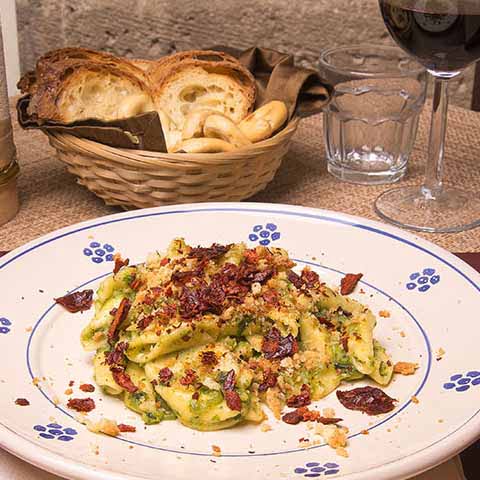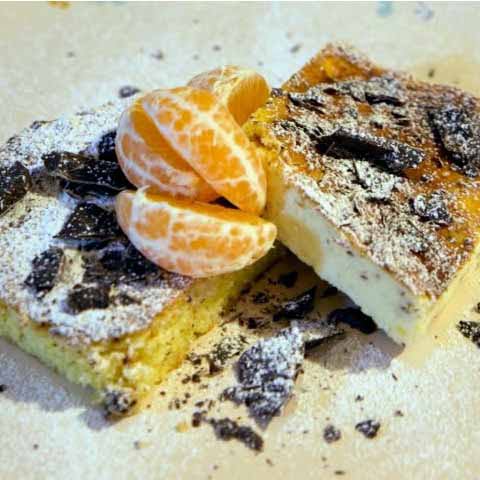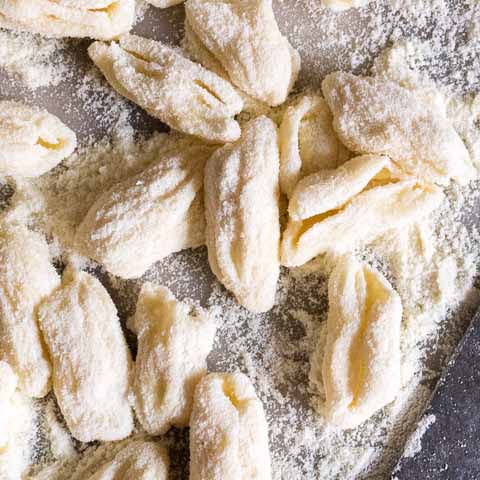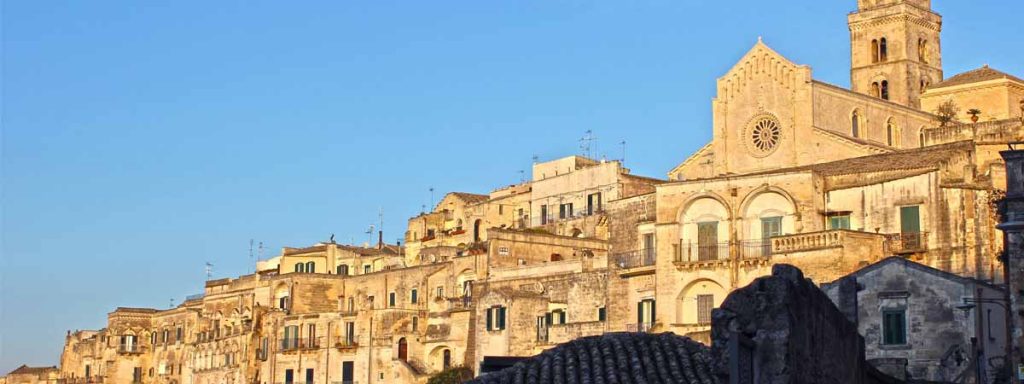To visit the city of Matera is to have time stand gloriously still in Southern Italy. Whether you are traveling through modern Matera or wandering the ancient Sassi, the people and the land are loyal to their heritage and incorporate it still today in local cuisine and dining experiences.
Matera is considered to be one of the oldest continuously inhabited cities in the world, dating back to tenth millennium B.C. The legacy of its inhabitants over the years is still ingrained in current society, just one reason why Matera was declared one of two European Capitals of Culture for 2019. Here, a time-honored cultural concept referred to as Cucina Povera reigns, meaning that the people believe in the pleasures of simple food with rich flavor that is built on inexpensive, accessible, and local ingredients. Additionally, because of Matera’s location along the border with Apulia, several culinary techniques and ingredients are shared between the neighbors.
Locals make almost everything here, from appetizers to desserts, fresh and by hand with detailed instruction from ancient traditional recipes. Some of the secret ingredients of cuisine in Matera include sun-dried peppers that are used to add flavor to many dishes and a special flour called farina di grano arso. The flour is gray in appearance and has an earthy, nutty flavor that gives Matera’s pasta extra flair. The bread of Matera is something special too. Known for its distinct flavor and shape, Matera’s bread has been granted PGI (Protected Geographical Indication) status.
Dining in Matera is an experience to be enjoyed and celebrated. From start to finish, a leisurely meal can take a couple of hours and is best spent in the company of family, friends, and with a glass of locally produced wine.
APPETIZERS
Homemade bread in Matera is a staple. Not just any ordinary bread, it is made fresh and by hand daily and is a complement to many appetizers as well as first and second courses. Usually crusty on the outside, the bread has a characteristic shape that is reminiscent of the unique landscapes that surround Matera. When the locals lived in the Sassi, each family would prepare their loaves in-house and mark them with a family seal. The loaves would then be brought to one of the neighborhood ovens that was shared by the locals for baking. The seal helped each family ensure that they brought the correct loaves home. This custom remained in place until the 1950s when the locals left the Sassi.
Appetizers in Matera tend to feature a variety of cheeses and cured meats that are locally made. Some of the more often included meats are pancetta, salame pezzente (made from less-noble cuts of pork), and fennel flavored sausage. Cheeses featured may include caciocavallo podolico and buffalo mozzarella.
Caciocavallo is a local aged cheese made exclusively from Podolica cattle, which can be found grazing throughout the Murgia Plateau. Buffallo mozzarella, or mozzarella di bufala, is softer and is made from the milk of water buffalo. Both of these types of cheese are delicious and can frequently be found on pizza and as a garnish for first or second courses.
Like in many other Italian regions, above all in Southern and Central Italy, the locals in Matera also enjoy bruschetta as an appetizer. The versatile dish consists of grilled bread that is rubbed with garlic cloves. The simplest preparations are then topped with salt and a drizzle of extra virgin olive oil. However, a wide variety of toppings may be added such as tomato, vegetables, cured meats, cheese, or beans.
FIRST COURSE
One of a few non-pasta based first courses in Matera is a creamy legume soup called crapiata. From restaurant to restaurant, this simple peasant soup can vary in ingredients but is often made from chickling peas, farro, chickpeas, lentils, broad beans, beans, and potatoes. This soup is particularly popular as the weather turns cold as it warms the body from head to toe. No bowl of this legume soup is complete unless topped with a piece of homemade bread for scooping. This dish is so important to the local cuisine that each year it is celebrated on August 1.
Another favorite local soup is fave e cicoria. As one of the recipes shared with the Apulia region, the soup consists of pureed fava beans served with chicory.
Most first courses here are whole heartedly pasta based, a nod to authentic Italian cuisine. The two most popular types of pasta handmade locally and served at dinner tables in Matera are orecchiette and cavatelli. Traditionally, both of these pasta shapes were made with the local flour, called grano arso, giving the pasta a distinct taste.
Orecchiette is an ear-shaped handmade pasta. It is typically served with locally grown fresh vegetables (primarily broccoli rabe), sun-dried peppers, and bread crumbs. Another popular version is orecchiette alla materana, which features oven-baked pasta with tomato, ground lamb, mozzarella, and pecorino cheese. Strascinate are similar to orecchiette, though they have a more elongated shape. They may be served with vegetables or meat sauces.
Cavatelli pasta is a small circle or short strip of pasta with the edges rolled in to allow for a hollow shape in the middle. This type of pasta is usually served with mushrooms and pork. Cavatelli con pepperoni cruschi is pasta served with sun-dried peppers, ricotta salata, and fried bread crumbs. Cavatelli alla salsiccia pezzente is pasta mixed with sausage pieces and rich tomato sauce.
The dried peppers that accompany local dishes have a long history and were introduced to the area in the sixteenth and seventeenth centuries by Spanish explorers. These dried peppers (peperoni cruschi in Italian) are traditionally dried and then baked in the oven. Depending on personal preference, they can be fried in olive oil or reduced to a powder and sprinkled on various dishes.
SECOND COURSE
Many second courses in Matera’s cuisine are meat based. Lamb shoulder that is slow cooked is considered a delicacy and is generally served with fresh and in-season locally grown vegetables. Another lamb-based dish popular in the region is pignata, mutton that is slowly cooked in a traditional earthenware pot with potatoes, onions, celery, and tomatoes. Depending on personal preferences, cured meats such as salame or soppressata may also be added.
Tagliata di manzo, or grilled sirloin, is another local favorite, typically made from the meat of the Podolica cow.
A simple dish called Gnummredd or Gnummeriedde is a testament to Matera’s peasant culinary tradition when choice cuts of meat were not available or too expensive for the locals. The dish consists of offal and intestines that are seasoned and then grilled.
As an alternative to meat, locals also enjoy a salad featuring the local bread called cialledda. The salad is made using stale bread and can be prepared warm, with eggs, broccoli rabe, garlic, olives, and onions, or cold, with tomatoes, olives, and onions.
SIDE DISHES
Common side dish ingredients in Matera include vegetables, bread, and dried peppers. Among the local recipes are ciambotta lucana (eggplant served with dried peppers, onions, potatoes, and tomatoes), ciaudedda (potatoes served with artichokes, onions, and pancetta), patate ragannate (oven roasted potatoes served with tomatoes, onions, and breadcrumbs), and zafaran chin (oven roasted peppers filled with breadcrumbs, anchovies, and garlic).
STREET FOOD
Street food in Matera is delicious. Focaccia is a favorite of locals and visitors alike, often seasoned with olive oil, spices and fresh cherry tomatoes. Some versions are stuffed and may include interesting fillings such as anchovies and onion. Panzerotti, hailing from the nearby Apulia region, are semicircular, fried favorites that contain tomato sauce, mozzarella cheese and other ingredients. They are served hot and are great to enjoy while walking the area.
DESSERT
A light dessert enjoyed in Matera is a whipped ricotta, fig, and hazelnut mousse that delights the taste buds. Delicious cookies, called strazzate, that are made from eggs and almonds are another local favorite. They can be prepared plain, or other ingredients such as cinnamon, chocolate, or coffee may be added to impart additional flavor.
There are also several local desserts tied to holidays, such as pettole (small pieces of fried dough) and cartellate (fried dough and honey) that are both prepared during Christmas.
WINE
Even when served with the much sought-after homemade bread of Matera, no meal is truly complete unless it is enjoyed and savored with a glass of Italian wine. Almost exclusively enjoyed in Basilicata is the local favorite Aglianico del Vulture, which is an earthy red wine, produced in the province of Potenza.
In Matera specifically, there is a wine for every course of the meal. First courses are best enjoyed with Matera Bianco and Greco. Matera Rosso, Moro, and Primitivo di Matera pair well with second courses and heartier meat dishes and rich sauces. To toast and celebrate your arrival consider the delectable Matera Spumante.
Matera’s simple cuisine is inexplicably tied to the city’s storied past. As a result of the local peasant cooking tradition, the ingredients, such as dried peppers and bread, may be modest, yet they come together in delicious ways and pair perfectly with the local wine to result in meals that travelers will not soon forget.
Travel Guides
The Basilicata Region of Italy
The Cities of Basilicata, Italy




